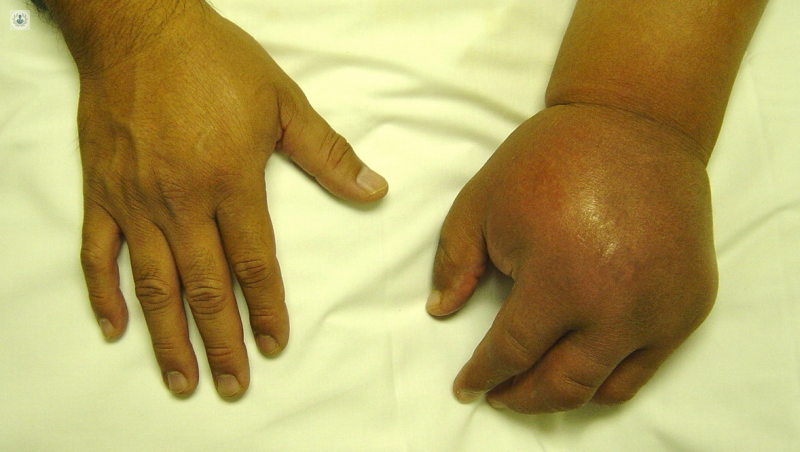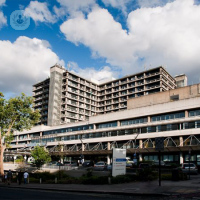Reflex sympathetic dystrophy syndrome (RSD)
Dr Anthony Ordman - Pain medicine
Created on: 11-13-2012
Updated on: 04-21-2023
Edited by: Jay Staniland
What is Reflex Sympathetic Dystrophy Syndrome (RSD)?
Reflex sympathetic dystrophy syndrome (RSD) is a condition that affects the sympathetic nervous system. It is a painful chronic condition that tends to last more than six months, it causes stiffness and discolouration in the affected area.

The nerves affected by reflex sympathetic dystrophy syndrome are located either side of the spinal cord and are responsible for certain bodily functions, such as opening and closing blood vessels.
This condition tends to affect hands and feet, although it can also affect arms and legs.
Reflex sympathetic dystrophy syndrome is also known as complex regional pain syndrome, Sudeck’s atrophy, reflex neurovascular dystrophy, causalgia, or shoulder girdle syndrome.
Prognosis for Reflex Sympathetic Dystrophy Syndrome (RSD)
The prognosis can greatly vary. It is thought that in young people, the disease prognosis is better. In some cases, despite treatment, the person affected will still experience pain and disability.
If treatment is started early, the condition can be halted, although not enough information is known about the disease progress.
What are the symptoms of Reflex Sympathetic Dystrophy Syndrome?
The most defining symptom of reflex sympathetic dystrophy syndrome is severe and long lasting pain.Iit can sometimes be chronic, which affects the person’s life and ability to rest. Sometimes the pain is described as a feeling of pressure, tingling, or even burning on the affected area.
Even though this condition normally only affects one limb, the pain can extend along the limb or to the opposite limb.
The affected area tends to be particularly sensitive to pain, with skin contact being extremely painful. This is known as allodynia.
People affected by this condition may experience body temperature changes as well as changes in skin tone.
The main symptoms are:
- prolonged pain
- skin texture changes in the affected area
- excessive sweating in the area
- stiffness and difficulty moving the affected joints
- muscle coordination issues
- muscle pain
- skin colour changes, these could be red or blue patches.
How is Reflex Sympathetic Dystrophy Syndrome diagnosed?
There isn’t a specific medical test that diagnoses this condition. Diagnosis is based on medical history, as well as signs of the condition.
The main sign is an issue with an injury in the affected area. An MRI may be requested to confirm the diagnosis.
Causes of Reflex Sympathetic Dystrophy Symdrome
The specific cause of the condition is still unknown, but it is known that in a lot of cases the condition appears due to an injury, the most common ones are:
- fractures
- soft tissues injuries, such as burns or blows
- sprains and/or strains
- immobilisation of the limb
In these cases, the condition is an abnormal bodily reaction that amplifies the effects of the injury or trauma. It can be compared to an allergic reaction in that some people will have an adverse reaction while others won’t be affected.
Blood vessels may leak fluid into the surrounding area, making the skin redden and swell. The muscles in the surrounding area may be starved of oxygen and could tighten or stretch.
How can Reflex Sympathetic Dystrophy syndrome be prevented?
This condition is still being researched, so little is currently known about how to prevent this condition.
What is the treatment for Reflex Sympathetic Dystrophy syndrome?
The most common treatments for this condition are:
- Rehabilitation and physical therapy: series of exercises to keep the affected area mobile. It aims to improve blood flow and decrease symptoms related to poor circulation.
- Psychotherapy: this condition quite often causes psychological issues such as; anxiety, depression, or post-traumatic stress disorder.
- Medication: some anti-inflammatory medications for pain can help.
- Blocking sympathetic nerves: many patients have claimed that this has given them some pain relief.
- Surgical sympathectomy: this is a controversial treatment that destroys nerves.
- Spinal cord stimulation: electrodes are placed on the spine, minor surgery is needed for this procedure.
- Neurostimulation: is used in the area of pain or discomfort.
- Intrathecal drug infusion pump: is used to relieve pain by administering pain relief medication, there is no evidence that it improves RSD.
What specialist should I see?
Reflex sympathetic dystrophy is treated by specialists in pain management.





